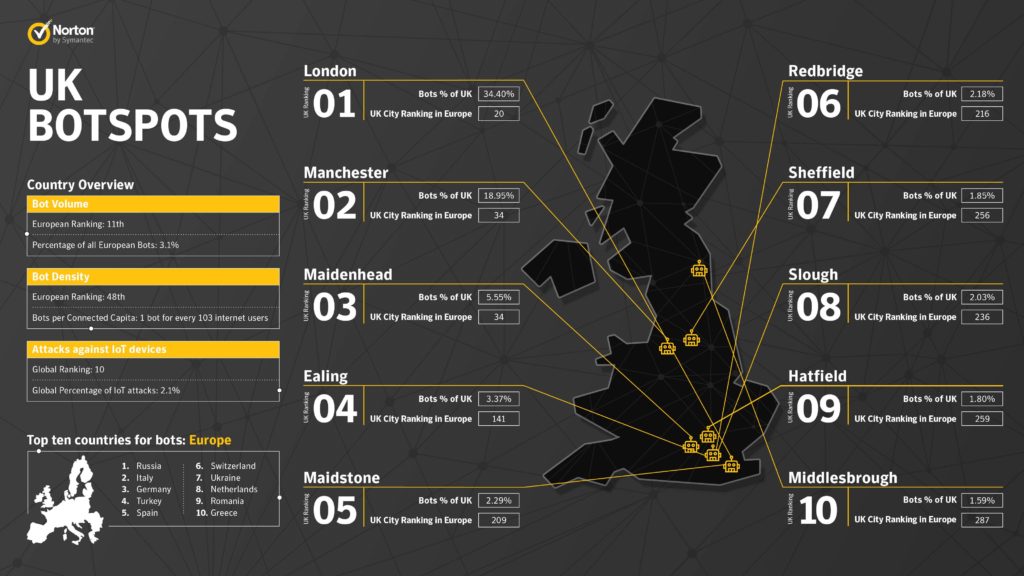Unsuspecting Brits Enable Global Cyber Crime, Research Shows

A year on from the Mirai botnet’s first major attack – which brought much of the internet to a standstill -Norton by Symantec (NASDAQ: SYMC), the world’s leading cyber security company, reveals how the global botnet has grown and which countries and cities unwittingly played host to the greatest number of bot infections. 6.7 million more bots joined the global botnet in 2016, and Europe made up nearly one-fifth (18.7 per cent) of the world’s total bot population.
According to global research from Norton:
• The United Kingdom was Europe’s 11th highest source of bot infections, falling from 7th place in 2015;
• Metropolitan London housed the majority of the UK’s bot infected (or “zombie”) devices with 34.4 per cent of all British bots;
• Manchester (18.95 per cent) came second with Maidenhead (5.55 per cent) making an unlikely bid for fame as the 3rd most bot infected city;
• Madrid ranked as the most bot-populous city in all of Europe, with more bots in the city than the entirety of the United Kingdom;
• The Holy See, the world’s smallest country, had the highest density of bots globally when comparing the number of infections to internet users
Bots are Internet-connected devices of any kind, such as laptops, phones, IoT devices, baby monitors, etc. infected with malware that allow hackers to remotely take control of many devices at a time, typically without any knowledge of the device owner. Combined, these devices form powerful bot networks (botnets) that can spread malware, generate spam, and commit other types of crime and fraud online.
“More than 13.8 million people in the UK were victims of online crime in the past year, and bots and botnets are a key tool in the cyber attacker’s arsenal,” commented Candid Wueest, Norton Security Expert. “It’s not just computers that are providing criminals with their robot army; in 2016, we saw cyber criminals making increasing use of smartphones and Internet of Things (IoT) devices to strengthen their botnet ranks. Servers also offer a much larger bandwidth capacity for a DDoS attack than traditional consumer PCs.”
In fact, IoT devices may be part of the uptick in global bot infections in 2016. During its peak last year, when the Mirai botnet – made up of almost half a million Internet-connected devices such as IP cameras and home routers – was expanding rapidly – attacks on IoT devices were taking place every two minutes. Unbeknownst to the device owners, nearly a third (31 per cent) of attacks originated from devices in Europe alone. The UK accounted for 2.7 per cent of global IoT attacks in 2016, the 4th highest in Europe.
However, where a bot resides is not indicative of where its creator may live- an infected device in London, for example, could contribute to an attack in Asia, and be controlled by a cybercriminal somewhere in the United States.







